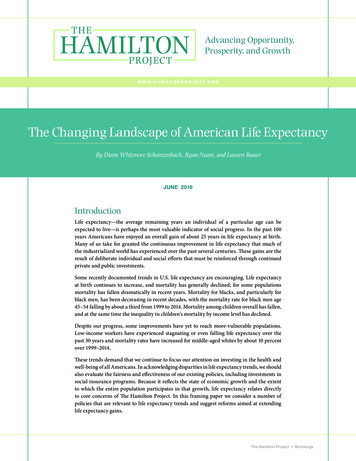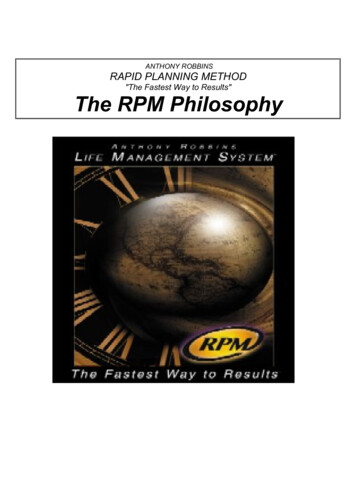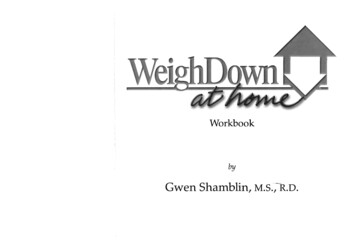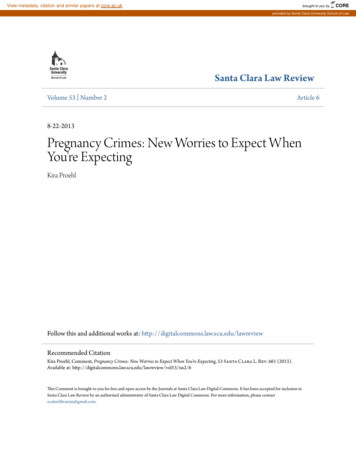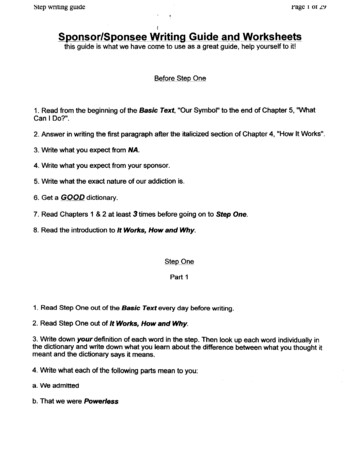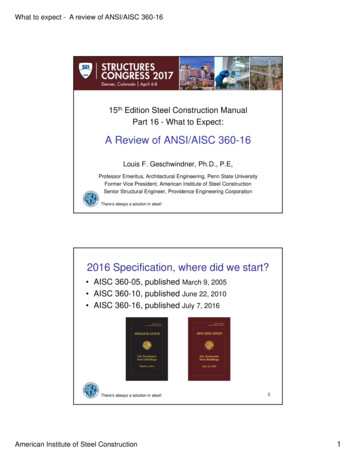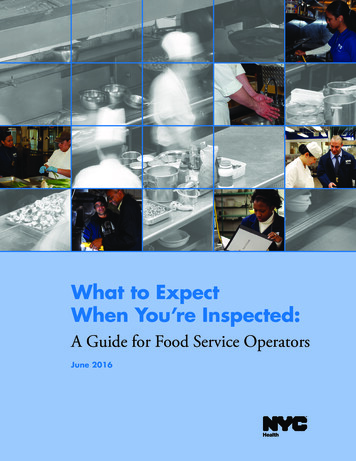
Transcription
What to ExpectWhen You’re Inspected:A Guide for Food Service OperatorsJune 2016Michael R. BloombMayorThomas Farley, M.Commissioner
What to Expect When You’re Inspected:A Guide for Food Service OperatorsIntroduction . . . . . . . . . . . . . . . . . . . . . . . . . . . . . . . . . . . . . . . . . . . . . . . . . . . . 2Food Safety Requires Active Management . . . . . . . . . . . . . . . . . . . . . . . . . . . . . 2The Food Protection Course and Certificate . . . . . . . . . . . . . . . . . . . . . . . . . 2The Inspection . . . . . . . . . . . . . . . . . . . . . . . . . . . . . . . . . . . . . . . . . . . . . . . . . . 3Scored Violations . . . . . . . . . . . . . . . . . . . . . . . . . . . . . . . . . . . . . . . . . . . . . 3nCritical and General Violations . . . . . . . . . . . . . . . . . . . . . . . . . . . . . 3nCondition Levels . . . . . . . . . . . . . . . . . . . . . . . . . . . . . . . . . . . . . . . . 4Unscored Violations . . . . . . . . . . . . . . . . . . . . . . . . . . . . . . . . . . . . . . . . . . . 4The Inspection Report and Notice of Violation . . . . . . . . . . . . . . . . . . . . . . . 4Closings and Re-openings . . . . . . . . . . . . . . . . . . . . . . . . . . . . . . . . . . . . . . . 5Restaurant Inspection Website . . . . . . . . . . . . . . . . . . . . . . . . . . . . . . . . . . . . 5Grading . . . . . . . . . . . . . . . . . . . . . . . . . . . . . . . . . . . . . . . . . . . . . . . . . . . . . . . 5Every Restaurant Can Achieve an “A” . . . . . . . . . . . . . . . . . . . . . . . . . . . . . . . . .7Food Service Establishment Inspection Scoring Parameters:A Guide to Conditions . . . . . . . . . . . . . . . . . . . . . . . . . . . . . . . . . . . . . . . . . . . . 8Critical Violations . . . . . . . . . . . . . . . . . . . . . . . . . . . . . . . . . . . . . . . . . . . . . 8General Violations . . . . . . . . . . . . . . . . . . . . . . . . . . . . . . . . . . . . . . . . . . . . 19Self-Inspection Worksheet for Food Service EstablishmentsSpecial foldout section after page 12
What to Expect When You’re Inspected:A Guide for Food Service OperatorsIntroductionThe New York City Health Department inspects approximately 27,000 food service establishments(sometimes called “restaurants” here) each year to monitor their compliance with City and Statefood safety regulations. This guide reviews the inspection process, provides information on therestaurant grading program and includes the Food Service Establishment Self-Inspection Worksheet (afterpage 12) and Food Service Establishment Inspection Scoring Parameters: A Guide to Conditions (page 8).All food workers, including wait staff, should know how to prepare and handle food safely to prevent foodrelated illnesses . Owners and managers should study this guide, share it with their employees and use theSelf-Inspection Worksheet (after page 12) to regularly check their restaurants’ physical and environmentalconditions and their employees’ food-handling practices .The regulations governing these Health Department inspections are in the Rules of the City of New York,Title 24, Chapter 23, titled “Food Service Establishment Inspection Procedures .”Food Safety Requires Active ManagementOperators who monitor their sanitary practices daily and correct violations on their own are more likely todo well on inspections . The Health Department encourages all operators to take advantage of its onlineresources and classroom courses to learn how to practice food safety and conduct self-inspectionsto manage and avoid Health Code violations .The Food Protection Course and CertificateTo promote active management, the Health Code requires food service establishments to have a supervisor offood operations with a Food Protection Certificate on duty during all hours of operation to supervise foodpreparation and processing . To avoid gaps in supervision, the Health Department recommends thatrestaurants have more than one staff person with a Food Protection Certificate .Individuals can earn a Certificate by taking and passing the Health Department’s food protection course,which trains operators in food safety and regulatory requirements . Classes are offered in multiple languagesat the Department’s Health Academy and online in English, Chinese and Spanish (http://www1 .nyc ion-online-free.page). The Academy course runs over five half days, Mondaythrough Friday, with an exam held on the last day. The onlinecourse can be taken at any time, but the final exam must betaken at the Health Academy. Department-approvedfood protection classes are also offered by the City Universityof New York and the New York State Restaurant Association.Supervisors who have passed one of these classes are eligibleto earn a certificate after taking an abbreviated course at theHealth Academy and passing a test.2A Guide for Food Service Operators
The InspectionEvery food service establishment in New York City receives anunannounced, onsite inspection at least once a year to check if it ismeeting Health Code food safety requirements. The inspector mayvisit anytime the restaurant is receiving or preparing food or drink,or is open to the public.Health Department inspectors hold bachelor’s degrees with significantcoursework in science. All inspectors undergo months of intensepublic health and communications instruction before they conductan inspection on their own. They are taught to identify and explainto operators which hazards contribute to food-borne illnesses and todocument these accurately in an inspection report.It is a crime to offer—or for the inspector to demand—money, gifts or services of any kind. Legal action willbe taken against anyone who offers or accepts a bribe. To report a bribe, or attempted bribe, call the InspectorGeneral’s office at 212-825-2141.Scored ViolationsThe inspector records observed violations in a handheld computer during the inspection. Each violation isassociated with a range of points depending on the type and extent of the violation, and the risk it posesto the public. At the end of the inspection, the points are added together for an inspection score. Lowerinspection scores indicate better compliance with the Health Code.Critical and General Violations.“Pre-permit serious items” are critical violations in the design of an establishment, such as improper sewagedisposal or lack of a hand-washing facility near the food preparation area. The Health Department will notissue a permit if the establishment has one of these conditions. These violations must be corrected before therestaurant opens, or immediately if the establishment is already open to the public. Because these violationsare critical to safe design and operation of the food service establishment, they carry the most points.TIP:Critical and general violations are listed in the Self-Inspection Worksheet included inthis booklet. Public health hazards are marked with an asterisk (*) and pre-permitserious violations are marked with a plus sign ( ).A Guide for Food Service Operators3
Condition LevelsThe number of points an establishment receives for a critical or general violation dependson its condition level, meaning the extent and frequency of the violation. Everycondition level is determined by a specific set of parameters (see Page 8, FoodService Establishment Inspection Scoring Parameters – A Guide to Conditions).Some violations have more condition levels and parameters than others.Conditions range from Level I, which carries the fewest points, toLevel V, which carries the most points. For example, the presence ofone contaminated food item would constitute a Condition LevelI violation and would generate the fewest critical violation points.Four or more different contaminated food items would be aCondition Level IV violation, and the operator would be assessedmore violation points. Condition Level V, in most instances, isused to score public health hazards that are not corrected atthe time of the inspection and is usually assigned 28 points.Unscored ViolationsSome cited violations may result in a Notice of Violation,.The Inspection Report and Notice of ViolationAt the end of the inspection, the inspector will:nnnnR eview the results of the sanitary inspection with the operator, explain violations and suggest ways tocorrect them and improve food safety. Cited violations should be corrected as soon as possible, and theestablishment should take steps to prevent them from recurring.I ssue a printed Inspection Report that states what the inspector observed, the violation points and theinspection score.I ssue a Notice of Violation if the score was 14 or more points in general violations. The inspector mayissue a Notice of Violation if a critical violation or an unscored violation was cited. All Notices ofViolation are signed by the inspector and the food service operator.P rovide the date when the Notice of Violation will be heard by a hearing examiner at the Health HearingsDivision of the Office of Trials and Hearings (OATH). The back of the Notice of Violation includescontact information for OATH, a description of the hearing process and information about settlementand hearing by mail. Fines are determined at OATH. They range from 200 to 2,000 per violation andmay be higher for repeated violations.TIP:44Use the Self-Inspection Worksheet and Guide to Conditions in this booklet to conductregular self-inspections. These worksheets provide examples of the violations inspectorslook for and the points they assign for each. By regularly identifying and immediatelycorrecting violations in your establishment, you not only protect your customers butimprove your chances of a successful inspection.A Guide for Food Service Operators
Closings and Re-openingsThe Health Department may order a restaurant to temporarily close to correct a public health hazard thatcannot be corrected before the end of an inspection or when the restaurant is operating without a validpermit. A restaurant may also be closed if it scores 28 or more points on three consecutive inspections. Priorto closure, an inspector will contact a supervisor, who will determine whether to order the establishmentclosed. If it is closed, Health Department closure signs must be immediately posted in the window(s)and/or door(s), all operations must cease and the restaurant must remain closed for business until it isauthorized by the Health Department to reopen. The Department will monitor the establishment toensure it remains closed and will issue additional violations for not complying with the closing order.To reopen, the establishment must submit a written statement to the Health Department indicating that ithas corrected all the violations that led to its being closed. The operator may be asked to attend an informalmeeting with Health Department supervisors. If it appears that sanitary conditions have improved, aninspector will conduct a reopening inspection while the establishment remains closed to the public. HealthDepartment supervisors will determine whether it may reopen.After re-opening, the establishment will be inspected for compliance with the Health Code. If it is insufficient compliance, it may remain open and will be inspected again in about three months. Repeatedviolations may prompt the Health Department to initiate procedures for the revocation or suspensionof the operator’s permit at a hearing before OATH. This may result in the establishment being closedfor a longer period of time, or permanently.Restaurant Inspection WebsiteConsumers may check an establishment’s inspection history. Restaurant scores, grades and the detailsof inspection results are available on the Health Department’s searchable restaurant inspection websiteat nyc.gov/health/restaurants.GradingAs of July 2010, certain types of food service establishments—including restaurants, coffee shops, bars,nightclubs and most cafeterias and fixed-site food stands—must post letter grades that correspond totheir sanitary inspection scores. A score of 0-13 results in a grade of A; 14-27 points, a B; and 28 ormore points, a C.Letter grades are not issued to mobile food vending units, temporary food service establishments, foodservice establishments operated by primary or secondary schools, hospital-operated cafeterias, correctionalfacilities, charitable organizations (including soup kitchens or other prepared food distribution programs)or food service establishments operated by not-for-profit membership organizations that serve food only totheir members.TIP:Restaurants with A grades are inspected less often than those with B or C grades.Score 0 to 13 points A; Score 14 to 27 points B; Score 28 or more points CA Guide for Food Service Operators5
Only certain inspections result in a grade. Every food serviceestablishment is scheduled for at least one inspection per year. Arestaurant that scores 0 to 13 violation points on its first inspectionwill receive an A-grade card that must be posted immediately.An establishment that does not score an A on its initial inspectionwill not have to post a grade until it has had the opportunity toimprove its sanitary conditions and is re-inspected. If an A is issuedon re-inspection, the A-grade card must be posted immediately. Anestablishment receiving a B or C grade on re-inspection receivestwo cards: one showing the letter grade and one that says “GradePending”; one of those cards must be posted immediately.The final grade is determined at OATH.The frequency of inspections depends on a restaurant’s score.Restaurants with A grades are inspected less often than thosewith B or C grades. Frequent inspections of poorer-performingestablishments enable the Health Department to closely monitortheir food safety practices, while giving them more opportunitiesto improve their grades.The letter grade or “Grade Pending” card must be posted in a placewhere it is easily seen by people passing by. It must be on the frontwindow, door or an outside-facing wall. The card must be within 5feet from the front door or other entrance, and within 6 feet fromthe ground or floor.SANITARY INSPECTION GRADECard NumberEstablishment NameDate IssuedFor additional informationor a copy of an inspectionreport, call 311 or visitnyc.gov/healthSANITARY INSPECTION GRADECard NumberEstablishment NameDate IssuedFor additional informationor a copy of an inspectionreport, call 311 or visitnyc.gov/healthFor additional information visit rs.page6A Guide for Food Service Operators
EVERY RESTAURANT CAN ACHIEVE ANAvoid Common Sanitary ViolationsFollow the steps below to practice A-grade food safetyand keep your customers safe from food-borne illness.Avoid the most commonly cited violations and improveyour chances to achieve an “A.”Be sure employees are trained in basic foodsafety and supervised by someone who hasa food protection certificate.nnnArrange work schedules so that a supervisor with a foodprotection certificate is on duty whenever your restaurantis receiving or preparing food, or is open to the public.Train supervisors to use the Self-Inspection Worksheet toregularly evaluate and improve the restaurant’s conditionand employees’ food safety practices.Provide food safety training for all employees whohandle food.Hold food at the proper temperature.nnnnBe sure equipment used to hold hot and cold foodis working properly.Use thermometers to monitor the temperature of foodsin hot or cold storage.Track food taken from hot or cold storage, and recordhow long it is out.Seal all cracks, crevices and holes in walls, cabinets and doorsto prevent rodents, cockroaches and flies from entering.nInstall rodent-proof door sweeps on outside doors.nStore food and garbage in pest-proof containers.nnnnnKeep food covered until served.Keep food separated by temperature and type.Avoid cross-contamination by separating potentiallyhazardous foods (like raw poultry) from ready-to-eatitems (like salad mix).Maintain all food surfaces.nnReview Health Department rules for temperatureholding requirements.Control conditions that promote pests.nProtect food from contamination during storage,preparation, transportation and display.Clean and sanitize all food-preparation surfaces aftereach use; remove caked-on food.Repair or replace deeply-grooved cutting boardsand chipped or broken surfaces so they can beproperly sanitized.Maintain all non-food surfaces.nnReview Health Department rules on acceptablematerials; surfaces should be smooth and cleanable.Keep all surfaces clean.Maintain all plumbing and check it frequently.nnnMonitor all plumbing fixtures and make neededrepairs immediately.Be sure plumbing is fitted with approved devices(valves, anti-siphonage pieces, vacuum breakers)to prevent backflow.Clean and maintain grease traps.Clean grease, oil and food particles from all surfacesand equipment, including the floor underneath.Keep range hoods clean and grease-free.Michael R. BloomberMayorContract with a pest control professional licensed to workin restaurants.Thomas Farley, M.D.CommissionerA Guide for Food Service Operators7
8FOOD SERVICE ESTABLISHMENT INSPECTION SCORING PARAMETERS: A GUIDE TO CONDITIONSCRIT ICAL VIOL AT I O N SA Guide for Food Service OperatorsVIOLATIONCONDITION ICONDITION IICONDITION III2A* Food not cooked torequired minimumtemperature.CONDITION IVFailure to properly cookmeats, comminuted meatsand other potentiallyhazardous foods (PHFs),unless a consumer specificallyasks for a serving of itemordered to be cooked belowthe minimum temperature.Failure to correct anycondition of a PHH atthe time of inspection.Inspector must call officeto discuss closing or otherenforcement measures.Failure to correct anycondition of a PHH atthe time of inspection.Inspector must call officeto discuss closing or otherenforcement measures.2B* Hot food item not heldOne hot food item out oftemperature in one area.Example: one tray of chickenwings held at 115 F.Two hot food items out oftemperature or the same typeof food out of temperature intwo different areas.Example: one tray of chickenwings and a pot of rice heldat 115 F; or one tray ofchicken wings on the steamtable and one tray of chickenwings in the food preparationarea held at 115 F.Three hot food items out oftemperature or the same typeof food out of temperature inthree different areas.Example: one tray of chickenwings, a pot of rice andplatter of roast beef held at115 F; or one tray of chickenwings on the steam table, onetray of chicken wings in thefood preparation area and onebasket of chicken near thedeep fryer held at 115 F.Four or more hot food itemsout of temperature or thesame type of food out oftemperature in four or moredifferent areas.Example: one tray ofchicken wings, a pot of rice,platter of roast beef andtureen of beef stew held at115 F; or one tray of chickenwings on the steam table, onetray of chicken wings in thefood preparation area, onebasket of chicken near thedeep fryer and a rotisseriemachine filled with elevenchickens held at 115 F.2CHot food item thathas been cooked andrefrigerated is being heldfor service without firstbeing reheated to 165 F orabove within 2 hours.One cooked and refrigeratedhot food item not reheated to165 F before service.Example: chicken soup.Two cooked and refrigeratedhot food items not reheatedto 165 F before service.Example: chicken soup andbaked ham.Three cooked and refrigeratedhot food items not reheatedto 165 F before service.Example: chicken soup,baked ham and sliced turkey.Four or more cooked andrefrigerated hot food itemsnot reheated to 165 Fbefore service.Example: chicken soup,baked ham, sliced turkey,meatloaf and lobster bisque.2DPrecooked potentiallyhazardous food fromcommercial foodprocessing establishmentthat is supposed to beheated, but is not heatedto 140 F within 2 hours.One precooked commerciallyprepared food not heatedto 140 F.Example: beef patties.Two pre-cookedcommercially preparedfoods not heated to 140 F.Example: beef patties andclam chowder.Three pre-cookedcommercially preparedfoods not heated to 140 F.Example: beef patties, clamchowder and smoked turkey.Four or more pre-cookedcommercially prepared foodsnot heated to 140 F.Example: beef patties, clamchowder, smoked turkey,corned beef and gyros.at or above 140 F.* Public Health Hazards (PHH) must be corrected immediatelyCONDITION V Pre-permit Serious (PPS) Violations that must be corrected before permit is issued
ERS:A GUIDEA GUIDETOTOCONDITIONSCONDITIONS(cont.)CRIT ICAL VIOL AT I O N S(cont.)VIOLATION2E2FWhole frozen poultryor poultry breasts, otherthan a single portion, arebeing cooked frozen orpartially thawed.CONDITION IOne whole poultry or poultrybreast being cooked from afrozen state.Example: chicken breast.CONDITION IITwo or more whole poultryor poultry breasts beingcooked from a frozen state.Example: chicken breast,whole chicken, turkey breastand duck.CONDITION IIICONDITION VNote: For failure to properly cook poultry to therequired minimum temperature, *2A cited.Meat, fish or molluscanshellfish served rawor undercooked withoutprior notificationto customer.2G* Cold food item heldCONDITION IVFailure to properly cookmeats, comminuted meats,fish, shellfish and otherPHFs, unless a consumerspecifically asks for theirorder to be cooked below theminimum temperature.One cold food item out oftemperature in one area.Example: one slab ofunsliced smoked salmon orpacket or tray of smokedsalmon slices above 38 F orone tray of potato salad above41 F in service display case.Two cold food items out oftemperature or the same fooditem out of temperature in2 different areas.Example: one slab of smokedsalmon above 38 F and onetray of sliced tomatoes above41 F; or one bowl of potatosalad in the service displaycase and one bowl of potatosalad in the food preparationarea above 41 F.Three cold food items outof temperature.Example: one slab of smokedsalmon above 38 F and trayof sliced tomatoes and platterof tuna salad above 41 F; orone bowl of potato salad inthe service display case andone bowl of potato salad inthe food preparation area andgarlic in oil mixture above41 F.Four cold food items out oftemperature.Example: one slab of smokedsalmon above 38 F and trayof sliced tomatoes, bowl ofgarlic in oil mixture andbowl of cooked collard greensabove 41 F; or one tray ofpotato salad in the servicedisplay case, one tray ofpotato salad in the reach-inrefrigerator and one tray ofpotato salad on the foodpreparation table above 41 F.Failure to correct anycondition of a PHH at thetime of inspection.Inspector must call officeto discuss closing or otherenforcement measures.One food item not cooled byapproved method whereby approved method.the internal productExample: one whole,temperature is reducedcooked turkey.from 140 F to 70 F or lesswithin 2 hours and from70 F to 41 F or less within4 additional hours.Two food items not cooled byapproved method.Example: two whole,cooked turkeys.Three food items not cooledby approved method.Example: two whole, cookedturkeys and one container ofdeep pot chicken stew.Four or more food items notcooled by approved method.Example: two whole, cookedturkeys, one container ofdeep pot chicken stew and 10pounds of cooked rice.Failure to correct anycondition of a PHH at thetime of inspection.Inspector must call officeto discuss closing or otherenforcement measures.above 41 F (smoked fishand Reduced OxygenPackaged food above38 F), except duringnecessary preparation.A Guide for Food Service Operators2H* Food not cooled by an9* Public Health Hazards (PHH) must be corrected immediately Pre-permit Serious (PPS) Violations that must be corrected before permit is issued
ETERS:A GUIDEA GUIDETOTOCONDITIONSCONDITIONS(cont.)CRIT ICAL VIOL AT I O N S(cont.)A Guide for Food Service OperatorsVIOLATIONCONDITION ICONDITION IIFood prepared fromingredients at ambienttemperature not cooledto 41 F or below withinfour hours.One food item preparedfrom ambient temperatureingredients not cooledto 41 F.Example: tuna salad preparedwith canned tuna above 41 F.Two food items preparedfrom ambient temperatureingredients not cooledto 41 F.Example: tuna and salmonsalads prepared with cannedtuna and salmon above 41 F.Three food items preparedfrom ambient temperatureingredients not cooledto 41 F.Example: tuna and salmonsalads prepared with cannedtuna and salmon, and opencan of sardines above 41 F.Four or more food itemsprepared from ambienttemperature ingredients notcooled to 41 F.Example: tuna and salmonsalads prepared with cannedtuna and salmon, andopen cans of sardines andanchovies above 41 F.Reduced Oxygen Packaged(ROP) food not cooledby an approved methodwhereby the internalproduct temperature isreduced to 38 F withintwo hours of cookingand if necessary furthercooled to a temperature of34 F within six hours ofreaching 38 F.One ROP food item notcooled by approved method.Example: ROP beef stew(twelve 4-oz packages).Two ROP food items notcooled by approved method.Example: ROP beef stew(twelve 4-oz packages) andROP chicken fricassee(two 2-lb packages).Three ROP food items notcooled by approved method.Example: ROP beef stew(twelve 4-oz packages),ROP chicken fricassee(two 2-lb packages) andROP pork tenderloin (sixteen8-oz packages).Four ROP food items notcooled by approved method.Example: ROP beef stew(twelve 4-oz packages),ROP chicken fricassee (two2-lb packages), ROP porktenderloin (sixteen8-oz packages) and meatsauce (six 1-lb packages).Failure to correct anycondition of a PHH at thetime of inspection.Inspector must call officeto discuss closing or otherenforcement measures.3A* Food from unapproved orOne or more food items notfrom an approved source, orhome canned.Example: wild mushroomsor home-canned jellies orROP fish not frozen beforeprocessing.Failure to correct anycondition of a PHH at thetime of inspection.Inspector must call officeto discuss closing or otherenforcement measures.3B* Shellfish not fromOne or more containers orkinds of shellfish not from anapproved source, improperlytagged/labeled; tags notretained for 90 days.Example: clams nottagged, oyster tags notretained for 90 days, musselsimproperly labeled andmussels not tagged.Failure to correct anycondition of a PHH at thetime of inspection.Inspector must call officeto discuss closing or otherenforcement measures.2I2J*unknown source or homecanned; Reduced OxygenPackaged (ROP) fish notfrozen before processing;or ROP food prepared onpremises transported toanother site.approved source,improperly tagged/labeled;tags not retained for90 days.* Public Health Hazards (PHH) must be corrected immediatelyCONDITION IIICONDITION IVCONDITION V Pre-permit Serious (PPS) Violations that must be corrected before permit is issued
ERS:A GUIDEA GUIDETOTOCONDITIONSCONDITIONS(cont.)CRIT ICAL VIOL AT I O N S(cont.)VIOLATIONCONDITION I3C* Eggs found dirty/cracked;1-6 dirty/cracked eggs orliquid, frozen or powdered liquid, frozen or powderedeggs not pasteurized.eggs not pasteurized.Example: four dirty and/or cracked eggs; or onecontainer of unpasteurizedliquid eggs.CONDITION IICONDITION IIICONDITION IVCONDITION V7-12 dirty/cracked eggs; ortwo containers of liquid,frozen or powdered eggs notpasteurized.Example: nine dirty and/or cracked eggs; or twocontainers of unpasteurizedliquid eggs.13-24 dirty/cracked eggs; orthree containers of liquid,frozen or powdered eggs notpasteurized.Example: 16 dirty and/or cracked eggs; or 14 dirtyand/or cracked eggs and twocontainers of unpasteurizedliquid eggs.25 or more dirty/crackedeggs; or four containers ofliquid, frozen or powderedeggs not pasteurized.Example: 25 or more dirtyand/or cracked eggs; or18 dirty and/or crackedeggs and one container ofunpasteurized liquid eggs.Failure to correct anycondition of a PHH at thetime of inspection.Inspector must call officeto discuss closing or otherenforcement measures.7-12 cans of food productsswollen, leaking or rusted andnot segregated fromconsumable food.Example: three cans oftomato paste swollen and twocans of salmon and two cansof mushrooms rusted andstored on food storage shelf.13-18 cans of food productsswollen, leaking or rustedand not segregated fromconsumable food.Example: 10 cans of tomatopaste swollen, two cans ofsalmon and two cans ofmushrooms rusted and storedon food storage shelf.19 or more cans of foodproducts swollen, leaking orrusted and not segregatedfrom consumable food.Example: 10 cans of tomatopaste swollen, two cans ofsalmon and two cans ofmushrooms rusted, and15 cans of baked beansleaking and stored on foodstorage shelf.Failure to correct anycondition of a PHH at thetime of inspection.Inspector must call officeto discuss closing or otherenforcement measures.3E* Potable water supplyPotable water supplyinadequate. Water or ice notpotable or from unapprovedsource. Cross connection inpotable water supply system.Failure to correct anycondition of a PHH at thetime of inspection.Inspector must call officeto discuss closing or otherenforcement measures.3F*Unpasteurized milk ormilk product present.Unpasteurized milk or milkproduct present.F
The Health Department may order a restaurant to temporarily close to correct a public health hazard that cannot be corrected before the end of an inspection or when the restaurant is operating without a valid . permit . A restaurant may also be closed if it scores 2
